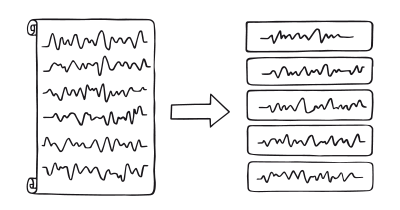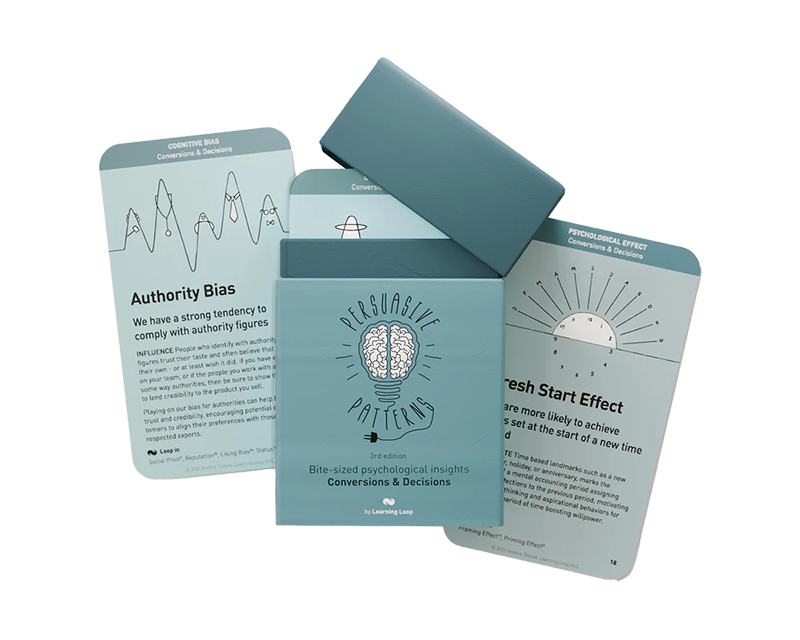Persuasive Patterns: Influence
Serial Positioning Effect
We remember the first and last items in a list better

The Serial Positioning Effect refers to the psychological tendency to better remember the first and last items in a list, while the middle items are less likely to be recalled.
Imagine you’re at a grocery store, standing in the cereal aisle. The shelves are filled with countless options, from sugary treats to healthy grains. You scan the shelves, and your eyes naturally gravitate towards the first few options at eye level and the last few as you complete your scan. You end up picking one from either the beginning or the end of your visual sweep. This is an example of the Serial Positioning Effect, where items at the beginning and end of a list (or in this case, a visual array) are more likely to be remembered and chosen. Research indicates that the serial position effect is due to the cue distinctiveness of end items in a serial list, facilitating their initial discrimination and storage in memory.
The same is true online. Imagine you’re scrolling through a streaming service, looking for a movie to watch. The platform displays a horizontal list of movie titles. Just like in the grocery store, you’re more likely to remember and select movies that appear at the beginning or end of the scrolling list. This is not a coincidence; it’s a design choice. Streaming services often place new releases or popular titles at these positions to capitalize on the Serial Positioning Effect. Research has shown that serial position effects in memory are not so much due to structural memory stores as to the working of cognitive strategy factors.
The study
One study that significantly highlights the power of the Serial Positioning Effect was conducted by psychologist Hermann Ebbinghaus in the late 19th century. Ebbinghaus’s experiments involved memorizing lists of nonsensical syllables and later testing his own recall. He found that the first and last items in his lists were more likely to be remembered than the items in the middle. This phenomenon illustrated how the arrangement of information could impact recall, thus informing fields like education and marketing.
Ebbinghaus, H. (1885). Über das Gedächtnis. Untersuchungen zur experimentellen Psychologie.
In design, the Serial Positioning Effect can be used to optimize the presentation of information, products, or choices to increase recall and favorability. Businesses and educators alike can utilize this pattern to arrange content so that critical or desired outcomes are positioned either at the beginning or end of a list, presentation, or set of options.
The psychological underpinning of the Serial Positioning Effect is deeply rooted in cognitive psychology, particularly in the area focusing on memory and information recall. In essence, this effect speaks to the way human memory works when processing sequences of items or pieces of information. There are two main components to this principle: the Primacy Effect and the Recency Effect.
- Primacy Effect
This component suggests that items at the beginning of a list or sequence are more likely to be remembered. One reason for this could be the greater amount of cognitive processing time allocated to these initial items. When we first start consuming a list, our attention and processing capabilities are generally at their peak. These first few items have a higher likelihood of moving from short-term to long-term memory storage. - Recency Effect
This is the tendency to better remember the most recent items in a sequence. This occurs because these items are still active in our short-term memory when recall is tested. Unlike the items in the middle of the list, which have been somewhat displaced, the recent items are still “fresh” in the cognitive system.

The recency effect disappears when people think about other matters for thirty seconds after the last item in the list is presented.
In both cases, the cognitive load plays a crucial role. Too much information overwhelms the cognitive system, and as a result, the items in the middle of the sequence are less likely to be remembered. This is called the “forgetting curve,” a concept also first introduced by Ebbinghaus. It describes how information is lost over time when there is no attempt to retain it.
Understanding the Serial Positioning Effect can have significant implications for various fields. In education, for example, this principle might suggest that key concepts should be introduced at the beginning or end of a lesson for better retention. In marketing, placing important product features or calls to action at the beginning or end of a list could lead to higher recall and possibly influence decision-making in favor of the product.
Designing products with the Serial Positioning Effect
While it’s easy to downplay the importance of remembering all the items on our grocery list, this scenario highlights a key issue with our memory. It’s common for people to forget items that appear in the middle of their grocery list. The seemingly trivial act of forgetting a couple of items on a list has wider implications for how our memory works, especially when it comes to the recall of serially presented information.
Now, consider the challenge of attending a fast-paced lecture where a professor is providing vital definitions. You’re taking notes as fast as possible, yet the professor’s speed makes it difficult to catch every word. If you reflect on your notes, you’ll likely notice that you’ve written down the beginning and end of what was said, but the middle part may be missing. This too, is the serial position effect at work.
Awareness of the serial position effect can help you develop strategies to improve recall. For instance, you could prioritize critical items at the beginning of a list. Repeating the list may not be enough, but actively rearranging it to favor your memory’s tendencies can make a difference.
When designing a product interface, it’s important to take into account the serial position effect. For example, placing the most vital features or information at the beginning or end of a list or a navigational menu could enhance user recall and satisfaction. Remember that users are more likely to remember the first and last items they interact with, so ensure that these are the most important or commonly used features.
Designers and teachers alike need to consider the serial position effect when designing curricula or lessons. An effective approach may include introducing vital concepts or summary points at the beginning or end of a class to facilitate better recall.
Ethical recommendations
One way the Serial Positioning Effect can be used unethically is in the manipulation of choices by strategically placing less beneficial or more expensive options at the beginning or end of a list, thereby taking advantage of the pattern to prioritize corporate gain over user benefit. This can be particularly problematic in sectors like healthcare, finance, or any other context where the stakes are high and the choices are consequential.
Another area of concern is the use of the Serial Positioning Effect in presenting terms and conditions or privacy policies. Often, critical information is buried within a long list of clauses. By placing less relevant or benign items at the beginning and end, organizations might manipulate users into thinking they have understood the key elements when they have not.
To ensure ethical application of the Serial Positioning Effect, a few guidelines can be followed:
- User benefit
Prioritize the user’s needs and benefits in the organization of information. The most crucial or beneficial items for the user should be the ones that are emphasized through this effect. - Context sensitivity
Be aware of the context in which the list is presented. In high-stakes scenarios, such as healthcare choices or financial decisions, extra care should be taken to not manipulate user choice through strategic item placement. - Informed consent
When dealing with policies or agreements, consider providing summaries or highlighting key clauses in a manner that does not exploit the Serial Positioning Effect to hide information.
Real life Serial Positioning Effect examples
Google places sponsored ads at both the top and the bottom of its search results, capitalizing on the serial position effect to maximize the visibility of paid content.
New York Times
In their digital and print articles, key takeaways or summary bullet points are often found at the beginning or end, making it easier for readers to remember the crux of the story.
Netflix
When auto-playing a series, the streaming service starts with a brief recap of what happened in previous episodes and often ends episodes with cliffhangers, making the beginning and end more memorable and encouraging continued viewing.
Trigger Questions
- Are we placing the most crucial features or information at the beginning or end?
- Have we considered the ethical implications of our design layout?
- Are we transparently indicating any prioritization of content or features?
- Is there a risk of cognitive overload by placing too many important items at the beginning or end?
- Are we regularly rotating items to give fair visibility to all options over time?
- Have we tested the effectiveness of our layout in facilitating user recall and satisfaction?
Pairings
Serial Positioning Effect + Scarcity Bias
Websites like Groupon show limited-time offers at the beginning and end of their lists, combining the scarcity bias with the serial positioning effect to create a sense of urgency.

We remember the first and last items in a list better

We value something more when it is in short supply
Serial Positioning Effect + Chunking
Platforms like Duolingo use chunking to break down information into smaller parts and use the serial positioning effect to place the most crucial information at the beginning and end of each chunk.

We remember the first and last items in a list better

We process and remember information grouped into manageable bits more easily
Serial Positioning Effect + Isolation Effect
This pairing works well in various applications, such as e-commerce websites, instructional design, and even in menus at restaurants. In these contexts, the combination of the Isolation Effect and Serial Positioning Effect can help draw attention and improve recall for key items, thereby influencing choices in a meaningful way. For example, in a product feature list on a software sales page, you might use the Serial Positioning Effect by placing the most important features at the beginning and end of the list for better recall. To integrate the Isolation Effect, you can further highlight these important features with a contrasting color or a unique icon. This ensures that not only are these features better remembered because of their positioning but also because they visually stand out.

We remember the first and last items in a list better

Items that stand out from their peers are more memorable
A brainstorming tool packed with tactics from psychology that will help you increase conversions and drive decisions. presented in a manner easily referenced and used as a brainstorming tool.
Get your deck!- On memory: A contribution to experimental psychology by Ebbinghaus
- Serial Position Effect of Free Recall by Murdock
- Ebbinghaus, H. (1885). Über das Gedächtnis. Untersuchungen zur experimentellen Psychologie.
- Murdock, B. B. (1962). The serial position effect of free recall. Journal of Experimental Psychology, 64(5), 482–488.
- Glanzer, M., & Cunitz, A. R. (1966). Two storage mechanisms in free recall. Journal of Verbal Learning and Verbal Behavior, 5(4), 351–360.
- Skoff, B., & Chechile, R. (1977). Storage and retrieval processes in the serial position effect. Bulletin of the psychonomic society, 9, 265-268.
- Helstrup, T. (1984). Serial position phenomena: Training and retrieval effects. Scandinavian Journal of Psychology, 25, 227-250.
- Glenberg, A. M., Bradley, M. M., Stevenson, J. A., Kraus, T. A., Tkachuk, M. J., Gretz, A. L., Fish, J. H., & Turpin, B. M. (1980). A two-process account of long-term serial position effects. Journal of Experimental Psychology: Human Learning and Memory, 6(4), 355–369.
- Glanzer, M., & Cunitz, A. R. (1966). Two storage mechanisms in free recall. Journal of Verbal Learning and Verbal Behavior, 5, 351-360.
